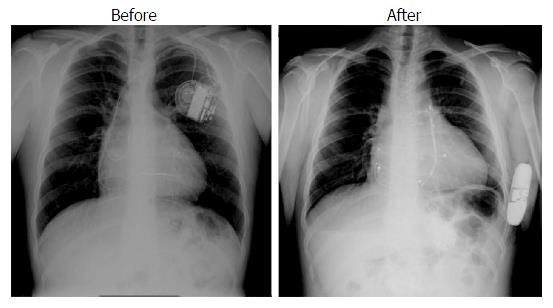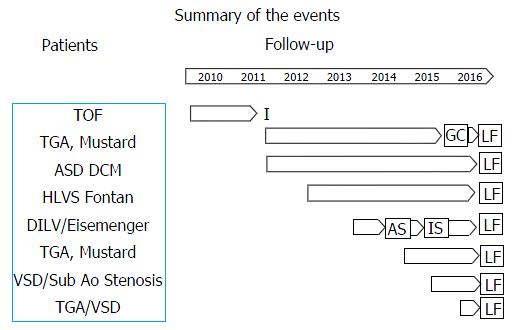Copyright
©The Author(s) 2017.
World J Cardiol. Jun 26, 2017; 9(6): 547-552
Published online Jun 26, 2017. doi: 10.4330/wjc.v9.i6.547
Published online Jun 26, 2017. doi: 10.4330/wjc.v9.i6.547
Figure 1 A new transeptal endocardial lead was implanted in the left ventricle and the atrial septal defect was thereafter successfully closed with an occlude device.
A: Subcutaneous implantable cardiac defibrillator and endocardial pacing system in a patient post Mustard operation; B: Patient with ASD and dilatative DCM who previously underwent left ventricle lead implant; C: Patient with Eisenmenger syndrome. ASD: Atrial septal defect; DCM: Dilatative cardiomyopathy.
Figure 2 Hybrid implant (subcutaneous implantable cardiac defibrillator and epicardial pacing).
The patient developed severe tricuspid regurgitation related to the endocardial lead previously implanted.
Figure 3 Summary of the events during follow-up according to different anatomic background.
TOF: Tetralogy of Fallot; VSD: Ventricular septal defect; TGA: Transposition of great arteries; DILV: Double inlet left ventricle; ASD: Atrial septal defect; HLVS: Hypoplastic left ventricle syndrome; I: Infection; IS: Inappropriate shock; AS: Appropriate shock; GC: Generator change; LF: Last follow-up; DCM: Dilatative cardiomyopathy.
- Citation: Ferrero P, Ali H, Barman P, Foresti S, Lupo P, D’Elia E, Cappato R, Stuart AG. Entirely subcutaneous defibrillator and complex congenital heart disease: Data on long-term clinical follow-up. World J Cardiol 2017; 9(6): 547-552
- URL: https://www.wjgnet.com/1949-8462/full/v9/i6/547.htm
- DOI: https://dx.doi.org/10.4330/wjc.v9.i6.547











